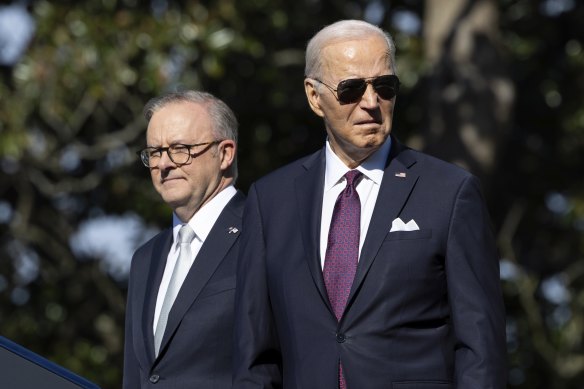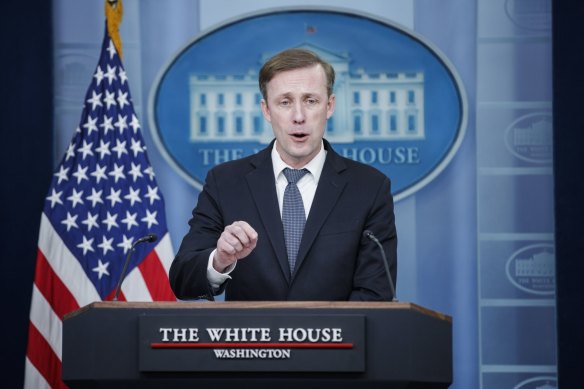The US is pushing for the AUKUS partnership to launch some world-leading new military technology projects before Joe Biden’s presidency ends, amid signs of growing impatience with the initiative.
The US National Security Adviser, Jake Sullivan, revealed in an interview at the White House that he wanted to see “two or three signature projects launched and under way by the time the administration finishes” on January 20.

Prime Minister Anthony Albanese and US President Joe Biden during last year’s state visit to the US.Credit: Alex Ellinghausen
While he expressed satisfaction with progress on so-called pillar one of AUKUS, the submarine program, his timeline for pillar two’s cutting-edge tech scheme puts new pressure on the three countries’ military and scientific agencies to deliver in the next five months.
It is three years ago this month that the leaders of the US, UK and Australia announced the joint technology initiative. In the meantime, China has extended its advantage in critical technologies, according to a report last week by the Australian Strategic Policy Institute.
A former senior official in the Trump administration expressed frustration: “On the science and technology side, I think there are problems because we’re not moving fast enough,” said Nadia Schadlow, Deputy National Security Adviser to the former president.
“If AUKUS doesn’t perform, if it doesn’t do what it’s supposed to do and what we said it would do, we almost might be better off without it because if we can’t fulfil our objectives, we almost look weaker.”
Pillar two of AUKUS was assigned eight priority research fields: advanced cyber, artificial intelligence, quantum technologies, undersea capabilities, hypersonics, electronic warfare, innovation, and information sharing.
A Washington think tank sketched its potential power in a report last year: “If pillar one was historic, then pillar two promises to be revolutionary,” said the Centre for Strategic and International Studies.
“Each area of pillar two has game-winning potential in the strategic competition with China.”
But officials said privately that there were problems of co-ordination, that each of the country’s systems was different and moved at different speeds.
Australia’s Minister for Defence Industry and Capability Delivery, Pat Conroy, said: “We have made good progress on a number of projects. It’s certainly true that we are seeking an iconic, cut-through project.”
Areas of progress, he said, included sharing data between the three nations’ P8 submarine-hunting aircraft and successful joint exercises of undersea drones.
“They are really useful for advancing capability; they are not big bang like nuclear-powered submarines,” said Conroy.
While the first US nuclear-powered submarine to be sold to Australia is due in about 10 years’ time, the military tech program is supposed to deliver new capability within five.
“If we are now showing China that we can’t do any of the stuff that we’ve put down on paper, it becomes performative,” said Schadlow, the primary author of the 2017 US National Security Strategy and now a senior fellow at the Hudson Institute as well as an adviser to the Special Competitive Studies Project, a technology think tank.
“We’re almost worse off if there’s no progress to be made, because we’ve actually shown that despite our collective political will we can’t seem to actually speed things up, get things done, and deliver what we need in less than a decade.”
Sullivan told this masthead in the interview last week that, overall, AUKUS was developing well: “I think our handoff of that to the next administration, I’m going to feel that AUKUS is in very healthy shape, and we need to keep going.
“Now there’s going to be growing pains in it. There’s going to be challenges. Something as complex as this is going to generate that. But there’s huge possibility and promise there too.
“We have our work cut out for us on the submarine industrial base here in the US, but we put a lot of money aside to make that happen. That’s something I’m personally deeply focused on.”

US National Security Adviser Jake Sullivan. Credit: Bloomberg
Schadlow urged Australia to increase defence spending: “On the allies side, countries clearly need to do more, at least on the capability side. We know what needs to be done - more defence spending, more integrated planning, more actual development of capabilities, which is where some of AUKUS comes in.”
Schadlow said Australia’s announced defence spending equivalent to 2.1 per cent of GDP today and increasing to 2.4 per cent over a decade was inadequate:
“That’s lower than what it needs to be, especially given where Australia sits in terms of Asia, and the important role that it plays in AUKUS,” she said.
“I think there are real opportunities for the US and the Australians to cooperate on munitions production, for example. We can work together to improve our ability to produce them quickly at scale and speed.”
Cut through the noise of federal politics with news, views and expert analysis from Jacqueline Maley. Subscribers can sign up to our weekly Inside Politics newsletter here.